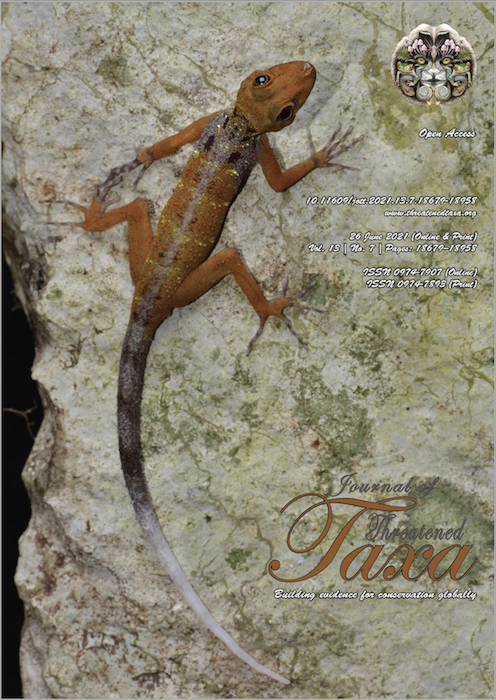Black-bellied Coral Snake Sinomicrurus nigriventer (Wall, 1908) (Elapidae): an extended distribution in the western Himalaya, India
DOI:
https://doi.org/10.11609/jott.7022.13.7.18939-18942Keywords:
Elapids, Indian Himalayan region, new recordAbstract
The Black-bellied Coral Snake Sinomicrurus nigriventer (Wall, 1908) was recently elevated to specific status from Himachal Pradesh where it was also known historically. We present here two individual observations of S. nigriventer from Uttarakhand State of India that constitute the first state record of the species increasing the distribution range ~105 km towards east in the western Himalaya.
References
Döring M. (2020). Elapidae, English Wikipedia - Species Pages. Wikimedia Foundation. Checklist dataset. Accessed via GBIF.org on 18 November 2020. https://doi.org/10.15468/c3kkgh
Kumar, A., M. Mitra, G. Singh & G.S. Rawat (2012). An inventory of the flora of Binog Wildlife Sanctuary, Mussoorie, Garhwal Himalaya. Indian Journal of Fundamental and Applied Life Sciences 2(1): 281–299.
Maikhuri, R.K. (2018). Biodiversity of Indian West Himalaya. The Himalayan Biodiversity 4:24–28.
Mirza, Z.A., V. Varma & P.D. Campbell (2020). On the systematic status of Calliophis macclellandi nigriventer Wall, 1908 (Reptilia: Serpentes: Elapidae). Zootaxa 4821(1): 105–120.
Mullin S. & Seigel (2009). Snakes: Ecology and Conservation. Cornell University Press, Comstock Publishing Associates, vi+384pp.
Nautiyal, S., K.S. Ranjan & R.S.C. Shibasaki (2005). Interaction of biodiversity and economic welfare- A case study from the Himalayas of India. Journal of Environmental Informatics 6(1): 16–24.
Pandit, M.K., N.S. Sodhi, L.P. Koh, A. Bhaskar & B.W. Brook (2007). Unreported yet massive deforestation driving loss of endemic biodiversity in Indian Himalaya. Biodiversity and Conservation 16(1): 153–163.
Reinhardt, J.T. (1884). Description of a new species of venomous snake, Elaps macclellandi. Journal of Natural History 4: 532–534.
Richardson, J.A. & S.E. Little (2012). Chapter 31: Toxicology, pp. 914–933. In: The Cat. Clinical Medicine and Management. Elsevier Inc., 1398pp. https://doi.org/10.1016/B978-1-4377-0660-4.00031-4
Smith, M.A. (1943). Fauna of British India, Ceylon and Burma, including the whole of the Indo-Chinese Sub-region. Reptilia and Amphibia. Vol. 3. Serpentes. Taylor and Francis, London, 583pp.
Smith, E.N., H. Ogale, V. Deepak & V.V.B. Giri (2012). A new species of coralsnake of the genus Calliophis (Squamata: Elapidae) from the west coast of peninsular India. Zootaxa 3437(1): 51–68. https://doi.org/10.11646/zootaxa.3437.1.5
Stephen J.M. & A.S. Richard (2009). Snakes - Ecology and Conservation. Cornell University Press, New York, xviii+381pp.
Uetz, P., P. Freed & J. Hosek (eds). (2020). The Reptile Database. http://www.reptile-database.org. Accessed on 14 December 2020.
Vasudevan, K. & S. Sondhi (2010). Amphibians and reptiles of Uttarakhand, India. Wildlife Institute of India, Dehradun, 94pp.
Wall, F. (1908). A new colour variety of MacClelland’s Coral Snake (Calliophis macclellandi) and extension of the habitat of the species. Journal of the Bombay Natural History Society 19: 266.
Whitaker, R. & A. Captain (2004). Snakes of India. The Field Guide. Draco Books, Chennai, 481pp.
Downloads
Published
Versions
- 26-06-2021 (2)
- 26-06-2021 (1)
Issue
Section
License
Copyright (c) 2021 Sipu Kumar, Jignasu Dolia, Vartika Chaudhary, Amit Kumar, Abhijit Das

This work is licensed under a Creative Commons Attribution 4.0 International License.
Authors own the copyright to the articles published in JoTT. This is indicated explicitly in each publication. The authors grant permission to the publisher Wildlife Information Liaison Development (WILD) Society to publish the article in the Journal of Threatened Taxa. The authors recognize WILD as the original publisher, and to sell hard copies of the Journal and article to any buyer. JoTT is registered under the Creative Commons Attribution 4.0 International License (CC BY), which allows authors to retain copyright ownership. Under this license the authors allow anyone to download, cite, use the data, modify, reprint, copy and distribute provided the authors and source of publication are credited through appropriate citations (e.g., Son et al. (2016). Bats (Mammalia: Chiroptera) of the southeastern Truong Son Mountains, Quang Ngai Province, Vietnam. Journal of Threatened Taxa 8(7): 8953–8969. https://doi.org/10.11609/jott.2785.8.7.8953-8969). Users of the data do not require specific permission from the authors or the publisher.





